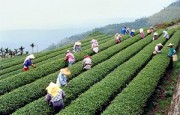|
 The first step in tea production is to pick the leaves. Taiwan oolong (also spelled wulong or wu long) can be harvested up to 6 times a year depending on the elevation and weather conditions. High mountain tea may only be harvested 3 times a year because the weather is much cooler and the tea grows more slowly. High mountain oolong is the most valued Taiwan oolong tea. The first step in tea production is to pick the leaves. Taiwan oolong (also spelled wulong or wu long) can be harvested up to 6 times a year depending on the elevation and weather conditions. High mountain tea may only be harvested 3 times a year because the weather is much cooler and the tea grows more slowly. High mountain oolong is the most valued Taiwan oolong tea.
The best quality oolong tea is hand-picked. Tea can also be machine cut, but this results in an excess of stems and damage to the leaves.
The tea leaves are picked as they are budding. One or two leaves along with the bud are plucked from the tea bush and placed in a large basket that the picker carries on her back. Most of the tea pickers are women.
The fresh leaves are transported back to the facility for processing tea. They are spread on a flat surface and exposed to the sun for about an hour. Afterwards they are gathered and placed on drying racks in an air-conditioned drying house.
At this stage of the tea production the leaves are shaken every hour so that the edges of the tea leaves bruise and oxidize. The tea leaves will lose approximately 20% of their moisture content during step in producing oolong tea. They also begin to turn brown due to the oxidation process.
To halt the oxidation the tea must be pan-roasted. The decision of when to roast the leaves depends on the judgment of the tea master. Oolong tea is usually oxidized between 20% and 80%. The tea master makes his decision of the level of oxidation depending on the type of leaves and the desired finished product. The amount that a particular tea leaf is allowed to oxidize before baking results in the range of oolong infusion color: from bright green or golden to amber or reddish infusions.
After pan-roasting, the next step in oolong tea production is to roll the tea leaves. The leaves are tightly packed in a canvas cloth and placed in a rolling machine. They are rolled for about 15 to 20 minutes, then again roasted. This rolling and roasting process is repeated up to 20 times.
The variables in tea production include the initial drying time, the time spent in the drying house, the frequency of tossing, the initial roasting time, and the number of times the leaves are rolled and re-roasted. Changing any of these variables results in a noticeable difference in the final product.
Tea production is labor intensive and the major reason why first grade oolong is so expensive. Regardless of the price, there is strong domestic market for top-quality oolong tea. Most of the oolong tea produced in Taiwan is for local consumption and the demanding Japanese market.
|